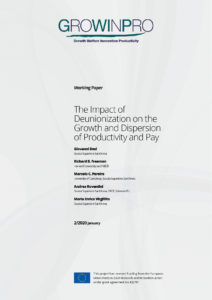This paper presents an Agent-Based Model (ABM) that seeks to explain the concordance of sluggish growth of productivity and of real wages found in macro-economic statistics, and the increased dispersion of firm productivity and worker earnings found in micro level statistics in advanced economies at the turn of the 21st century. It shows that a single market process unleashed by the decline of unionization can account for both the macro and micro economic phenomena, and that deunionization can be modeled as an endogenous outcome of competition between high wage firms seeking to raise productive capacity and low productivity firms seeking to cut wages. The model highlights the antipodal competitive dynamics between a “winner-takes-all economy” in which corporate strategies focused on cost reductions lead to divergence in productivity and wages and a “social market economy” in which competition rewards the accumulation of firm-level capabilities and worker skills with a more egalitarian wage structure.

 The Impact of Deunionization on the Growth and Dispersion of Productivity and Pay
The Impact of Deunionization on the Growth and Dispersion of Productivity and Pay